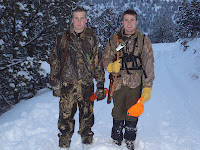 As summer winds down with Labor Day approaching, a new
group of backcountry travelers have moved into the woods – hunters.
As summer winds down with Labor Day approaching, a new
group of backcountry travelers have moved into the woods – hunters.
All too often, Search and Rescue teams are tasked to locate
folks that are lost, poorly prepared and are not carrying the right gear. It’s carrying the right gear in the
backcountry that I’d like to focus on for a moment.
Check lists for hunters abound on the Internet. You can find suggested equipment checklists
on forums and chat rooms, retailer’s and outfitter’s websites. All good stuff.
Personally, I build my check list on the foundation
established on the “ten essentials.” From the ten essentials I’ll add hunting
specific items. Here is what I use as my
baseline:
- Navigation
(map, compass & GPS)
- Sun
protection (Sun screen, sunglasses, a hat)
- Insulation
(extra clothing, gloves, knit hat, a sit pad)
- Illumination
(head lamp, flash light)
- First-aid
supplies (Check with the Red Cross’ web site or McCann’s book listed
below)
- Fire
starting material (metal match, cotton balls soak with petroleum jelly,
REI’s storm proof matches, BIC lighter)
- Repair
kit and tools
- Nutrition
(extra food)
- Hydration
(extra water) & filtration system
- Emergency
shelter (not a space blanket but a windproof water proof shelter, and a
blue poly tarp)
I’ll then add hunting
specific items to the list by including:

- Communications (signal mirror, a SPOT or
ACR locator beacon, cell phone)
- Knife, saw and game bags
- Shooting
sticks
- Surgical
gloves
- Hunting
license
I’ll take this list a step further by checking two of my
favorite reference books:
- Surviving a Wilderness
Emergency by Peter Kummerfeldt
- Build the Perfect
Survival Kit by John D. McCann
The intent of carrying all this gear is that should you
have to spend the unintended night or nights out you will be prepared. You may
not be comfortable but you'll have far better odds at surviving.
 I also recommend you involve children in the development
of your family’s gear check list. Listen
to their recommendations. Have them
carry their gear too. Start them early
and teach them what you know. Let them
participate.
I also recommend you involve children in the development
of your family’s gear check list. Listen
to their recommendations. Have them
carry their gear too. Start them early
and teach them what you know. Let them
participate.
Have fun and be safe.






